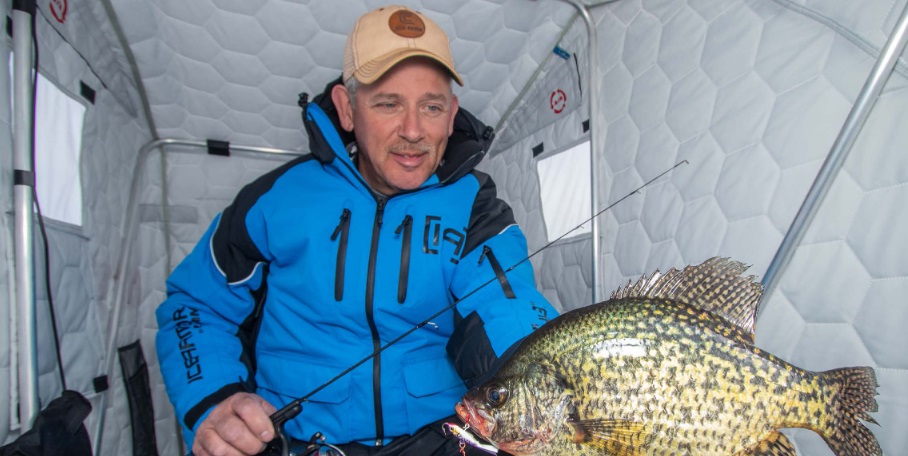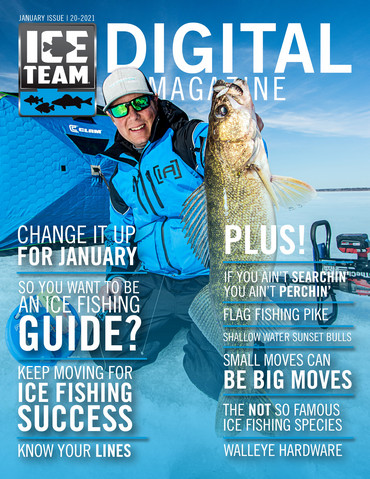
If you have ever ice fished for perch on one of the many reservoirs throughout the ice belt, you will have undoubtedly seen guys drilling tons of holes and constantly moving from hole to hole with their flashers looking for fish. That style of fishing (also known as “run & gun” fishing) is a popular way to fish for perch in deeper lakes and reservoirs.
The theory behind this is that the perch are always on the move looking for food, zooplankton in particular. The zooplankton will float through the water column at a particular depth, and where you find them, the perch are usually not too far behind.
While searching for perch, many guys will drill their holes in a grid type pattern, often times drilling up to 100 holes before ever starting to fish. Once the grid is drilled, the angler will either walk, or ride on an ATV, going from hole to hole. Once at each hole, they will check it with their Vexilar, and look for suspended fish.
Since the perch are busy following the zooplankton around, it is not worth fishing a hole that shows no fish on the Vexilar. You simply pull up the transducer, and move to the next one. When you find a hole with fish below it, you will know immediately. On the flasher, you will not mark individual fish, but the whole pod of fish. I have seen it before when in 80 feet of water, the school of perch will take up 30 feet of the water column. For the most part, the perch will show suspended 30 to 60 feet below the ice.
How to fish for perch 50 feet below the ice? There are many things that you can use for bait, but the most important factor is weight. Being able to get your jig in front of the perch before they move is key. I prefer spoon style jigs like the Speed Spoon from Clam Outdoors. It’s heavy and slender so it falls through the water fast, and it has a dropper chain with a small hook, so the fish are not intimidated to bite it. The Bomb Spoon from Clam is another great jig to use while chasing deep water perch.
Fishing with a small group of friends is a fun way to target these perch as well. When one of us finds the fish, we will call the other guys over in hopes of us all catching some before we lose them and have to start searching again.
Being efficient is another important factor while run and gun fishing. Most guys that spend a lot of time doing it will set up their ATV to be as efficient as possible. Ice fishermen in general are a pretty creative group of guys, and many of them will spend the time during the off season to build their own racks and storage systems to effectively hold everything they need to fish primarily off of their ATV. Since each fisherman’s style is a little bit different, these storage systems come in all shapes and sizes.
My personal rig is a side by side with racks and brackets t o hold everything I need for a day on the ice. I have two auger mounts, one for a 6’ auger, and one for an 8”. Both are cordless drill powered, so I can be as fast and efficient as possible when punching my numerous holes.
o hold everything I need for a day on the ice. I have two auger mounts, one for a 6’ auger, and one for an 8”. Both are cordless drill powered, so I can be as fast and efficient as possible when punching my numerous holes.
On the dash of my side by side is the GPS. Marking waypoints and routes of fish movement from years past has helped us narrow our search. Hanging off a bracket on the side is the Vexilar. Mounting the Vexilar on the side was one of the most efficient upgrades I made. While searching for perch, I can drive up to a hole, and drop the Vexilar transducer in it and immediately see if there is fish there. I will continue this process until I mark a school of fish, as mentioned earlier.
On the back is a custom rack that is designed to hold two Clam Scout ice shacks, if the school stays in one area long enough, I can set up a shack to get out of the elements. That’s not the only purpose for having the shack mounted there though. I also use it to store my rods, tackle, and bait.
Once a school of fish is found, all the tools necessary to catch the fish are sitting in the shack waiting for me. I simply turn around grab my favorite rod, make sure it is baited and drop the bait down the hole as quickly as possible.
The only negative to fishing for perch in deeper water is the risk of “popping” the perch while reeling them in. Popping is when the perches air bladder pops from the change in pressure from coming out of the deeper water. Since it is fatal to the fish, you are forced to keep it, so a person will pay strict attention to how the fish fights in hopes of determining the size of the fish. If the fish feels too small to keep, reeling it up slowly greatly decreases the chances of it popping.
The next time you are ice fishing on a reservoir, and you see a group of guys searching, don’t be afraid to ask if you can join them in the hunt for perch. Not only are most of them very friendly, and eager to help you learn the search method, but they often are looking for one more person to help drill holes and look for fish.
By: Craig Oyler
